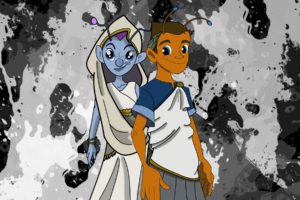Entic (ehn-tik)
The entic (Ehn-tik) people were the second largest people group in Fabella. Part of the halfling family, entics were largely characterized by their small stature, big eyes, and glowing antennae. An adult entic was only 4 – 5 feet tall. Their colorful glowing antennae greatly aided them in the dark and many early entics were nocturnal as a result. Early entics lived in burrows as opposed to above ground where they could be captured by slaveowners or killed by a lethal predator. They grew very little hair so they were uncomfortable in areas of extreme cold and preferred to live in sub tropical regions. Land around the equator was traditionally home to the higher populations of entics.
History
People — especially prime folk — frequently avoided referring to entics as equals. Much of entic history unfortunately involved them becoming indentured servants. Slavery was a part of the entic people’s heritage since their earliest known history. In the pre-exploration era, entic slaves were either born or acquired through purchase or capture. Unlike some of the other people in Fabella, entics never enjoyed a period when they were considered to be the most powerful people in any region. However, from this period of great emotional strife sprang a diverse culture of artisans in the fields of architecture, fashion, and music. Many of the cultural shifts throughout history were primarily driven by entic innovations, though they weren’t directly credited with these developments at the time.
Anatomy
All female entics were blue and all male entics were orange. They were additionally characterized by their big, bulbous, eyes and glowing antenna.
Antenna glowed in a variety of colors to light the entic’s way through the dark. Entic antenna made them a people highly connected to their emotions. They freely expressed their emotions to each other. Additionally, they were talented empaths capable of reading the feelings of others. Examples of mind-reading were rare. Therapists, psychologists, guidance counselors, and teachers were predominately entics because of the benefit given to them by their glowing antenna.
Culture
Language
Entic culture was originally an oral tradition spread via their private language of Ondur (Awn-door). Over time, this language was misunderstood and interpreted by some people to be “Under Tongue.” The Ondur language was assumed to have developed out of a need to communicate with other entics while in servitude. By speaking a language their masters couldn’t understand, entics didn’t have to be afraid of being overheard. It was the one thing nobody could take away from them. Entic slaves were so protective over the Ondur language that they would viciously attack any one of their number suspected for spreading it to their slavemasters.
Music
The music of the entic people was perhaps best known for an extremely advanced vocal tradition. “Sunbri (Suhn-bree)” a genre of sung poetry, which contained a series of proverbial phrases, praising or characterizing the respective person is of entic origin, and considered to be the oldest musical tradition. Hymns, anthems, and drinking songs originated primarily from entic culture. Entic music was regarded as the most important component of the modern music scene.
Art
Entic art was typified by paintings depicting figures with oversized eyes. They themselves had large eyes and this was a way of illustrating their cultural impact on Fabella as a whole. It was usually oil on canvas, some were actually present in museums on Earth. Perhaps the greatest piece of artwork influenced by entics was the animation in Walt Disney films, whose characters traditionally had oversized eyes.
Cuisine
The entics’ cuisine consisted of various vegetable or meat side dishes and entrées, usually a thick stew, served atop a large flatbread. Kifaloo, a pudding made from barometz, was one of the widely accepted and favorite dishes of entics. They did not eat pork or shellfish of any kind because their stomachs were incapable of digesting the foods. It was also a common cultural practice of entics to eat from the same dish in the center of the table with a group of people.

